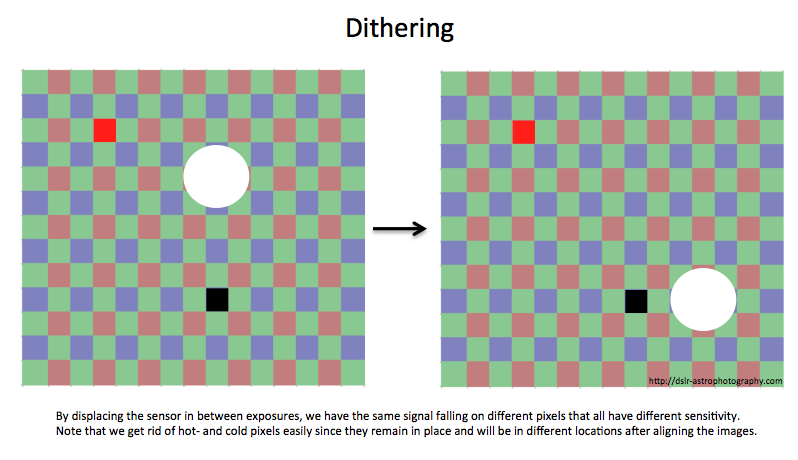With astrophotography we are in a constant battle with unwanted signal, trying to capture the faintest signals from space and get it to stand out above the noise. I’ve discussed the benefits of stacking a lot of frames previously, as this will greatly help to improve our SNR and dynamic range. Now it’s time to look at dithering and how that will benefit your images.
What is dithering?
When talking about dithering in astrophotography, we mean the displacement of the image sensor in regards to our target. In other words; we move the telescope + camera a bit so that the image is shifted on the sensor. In most cases this will be done by moving the guiding star a view pixels, but if you are working unguided you could just move the mount ever so slightly.
To get a better understanding what this does, let’s imaging our sensor and we have one tiny star that is captured by the pixel at position 1000,1000. Guiding should make sure that star is on this location every time. Now let’s throw in a hot pixel at position 150,150. That pixel will always be hot, in every frame. Now we start dithering in between frames; the star will not be captured by the same pixel, but instead the pixel at 1008, 1004 is capturing it. And the next frame the pixel at 1012, 1000, etc. etc.
The hot pixel however always remains at position 150,150.
Now we are going to stack the frames, but before we do, we of course register (align) all the frames. This means displacing the image to align the star that was captured by different pixels. What happens to the hot pixel? It is shifted to and will and up at different locations! This makes it very easy for the stacking process to get rid of these pixels by using some pixel rejection method.

The benefits of dithering
In our previous example we saw how easy it will be to get rid of hot pixels with dithering. The same goes of course for cold pixels. But there is more. Basically every ‘fixed pattern noise’ will benefit from dithering, in particular the thermal noise (dark current noise) we have to battle using uncooled DSLR camera’s. This thermal noise is of a fixed pattern, and thus shifting the image a bit over the pixels of the sensor will greatly benefit you as you can get rid of this thermal noise in the stacking process!
Apart from improving the noise levels of your image, you also benefit from the fact that you shift around the image over pixels that are not all performing equally well. As we noticed some pixels will be dead, cold or hot and so our signal there won’t be picked up as good as on other pixels. Furthermore, some pixels are more sensitive than others. If we wouldn’t shift the image, those signals that end up on those less efficient pixels won’t be picked up as clearly as on the other pixels. Shifting this around will greatly benefit you in that regards as well.
How to dither
Most guiding software will support dithering and will simply displace the image by a set amount of pixels by displacing the guiding star after every exposure. Of course it is very important that you either control the camera with the same software, or have some form of connection between the two as you don’t want to start displacing the image while you are still exposing!
Personally I use the Lacerta MGEN for my guiding and it supports dithering as well. That’s why it is so important for me that it can control my Nikon camera’s as well and is even able to support two camera’s at the same time. In a duo setup this allows you to still use dithering.
If you are not guiding yet you can of course just manually move the mount a little bit after each exposure.
In general it is advised to dither a minimum of 12 pixels and do so in a non-random way. Most software and guiding camera’s will use some maze like pattern to avoid using the same image placement on the sensor twice while still holding on as much as possible to your original field of view.
Conclusion on dithering
Dithering will greatly benefit any astrophotographer in getting a better SNR and get rid of bad pixels and fixed pattern noise. For users of non-cooled camera’s like most DSLR astrophotographers it is crucial to start dithering as it helps you get rid of most of the thermal noise so easily.

Came here with barely any understanding of dithering, this helped a lot. Next level stuff as always.
[…] Važno je da svaka sljedeća snimka bude pomaknuta za nekoliko desetaka piksela (eng.: dither) u odnosu na prethodnu! Posljedica je da će se mrlje izjednačiti i dobiti ćemo […]
[…] una deriva che poi sull’immagine finale genera quei bordi più scuri ai lati. Vedi anche: http://dslr-astrophotography.com/dithering-optimal-results-dslr-astrophotography/ e più ampiamente […]
[…] a small shift, a drift that then generates the final image darker sides those borders. See also: http://dslr-astrophotography.com/dithering-optimal-results-DSLRs-astrophotography/and more widely […]